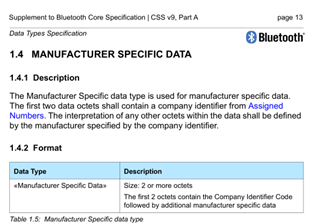Tool/software:
Hello. I am developing an application on the CC2652P7 processor, and the project is based on an example from the SDK. I have two devices, one of which acts as the master and the other as the slave. The master device is constantly in the air and transmits advertising packets. The slave device occasionally scans the air and looks for packets from the master device.
I want the slave device to update the advertising packet at a fixed interval. For example, the advertising packet will contain a simple counter that increments every second. The update will be performed using the functions "GapAdv_prepareLoadByBuffer" and "GapAdv_loadByBuffer."
In this regard, I have several questions:
- Is this acceptable in the context of the BLE standard?
- If it is acceptable, which of the "GAP Advertisement Data Types" should be used?
- According to the description, data types from 0x00 to 0x3D are already reserved. Is it permissible in the BLE standard to use other values, such as 0xAA? I know that there is also 0xFF (Manufacturer Specific Data), but it implies either use in testing, without commercial use, or monetary contributions. Therefore, this option is likely not suitable for us.
Perhaps the "GAP_ADTYPE_SERVICE_DATA" data type with the service UUID and data following it would be suitable for me?
Thank you for your help!


